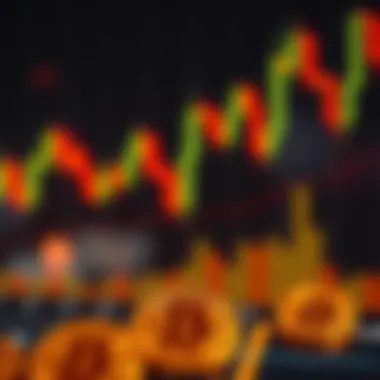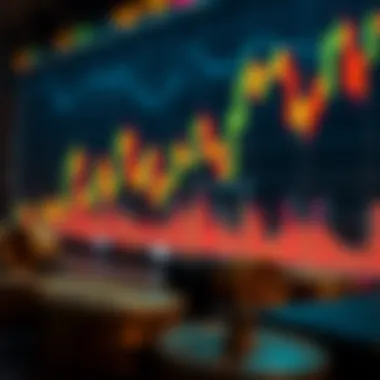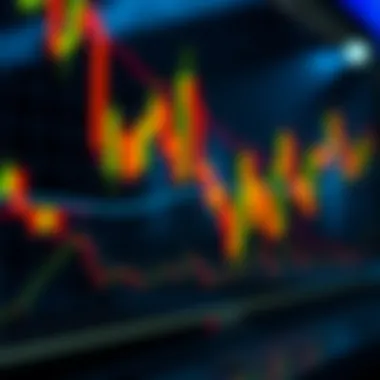Mastering Candlestick Patterns in Crypto Trading


Intro
In the realm of cryptocurrency trading, candlestick patterns have gained recognition as vital tools for traders seeking to make informed decisions. These patterns, which offer insights into price movements, encompass more than just simple charting techniques; they also capture the emotions and psychology of market participants.
Understanding how to read and interpret these patterns enables traders to anticipate market direction and respond swiftly to changes. This article explores the significance of candlestick patterns in cryptocurrency trading, their psychological underpinnings, and practical strategies to leverage this knowledge for better investment outcomes.
Without further ado, let’s dive into the current market scenario to see how candlestick patterns operate within it.
Foreword to Candlestick Charts
In the world of cryptocurrency trading, understanding market movements is crucial for making informed decisions. Candlestick charts serve as an essential tool, providing traders with a graphical representation of price action. This visual format makes it easier for traders to assess trends and potential reversals at a glance.
Definition and Origin
Candlestick charts originated in Japan in the 18th century, primarily used by rice traders to analyze price patterns. The traditional form of these charts captures the opening, closing, highest and lowest prices within a specific timeframe. Over the years, this technique has morphed into a widely used method across various financial markets, including cryptocurrencies. Candlestick patterns reveal not just price movements but also the underlying sentiment of the market participants.
Importance in Trading
The ability to interpret candlestick patterns is vital for traders looking to navigate the volatile seas of cryptocurrency. Here are some key reasons why they're important:
- Visual Insights: Candlestick charts allow traders to visually dissect price movements, simplifying the complexities of the digital market.
- Pattern Recognition: Certain formations, such as Doji or Engulfing patterns, can signal potential shifts in market trends, offering traders a chance to strategize effectively.
- Psychological Insights: Candlesticks encapsulate trader psychology. They convey emotions—fear, greed, and uncertainty—all of which play roles in market dynamics. This behavior can be spotted through specific patterns, leading to more informed decision-making.
Candlestick charts are not just tools; they are a language that speaks to the rhythm of the market, allowing traders to make sense of the chaos.
Understanding candlestick charts lays the foundation for further exploration into their fundamental components, diverse patterns, and the psychological aspects that drive market movements. As we dive deeper into these elements, traders can enhance their analytical skills, becoming more adept in their trading endeavors.
Fundamental Components of Candlesticks
The Body
The body of a candlestick represents the difference between the opening and closing prices during a specific time period. It's effectively the thick middle section of a candlestick and serves as a crucial indicator of buying and selling pressure. When the close price is higher than the open price, the body is typically filled with a lighter color, often green, signaling bullish sentiment where buyers have the upper hand. Conversely, if the close price is lower than the open price, the body is usually darker, often red, indicating that sellers dominated during that period.
Understanding the size of the body also holds significance. A long body signifies strong price movement and conviction in trader sentiment, whereas a short body reflects indecision or stagnation.
Wicks or Shadows
The wicks, or spirits as some may refer to them, extend from the body of the candlestick and indicate the highest and lowest prices reached within that timeframe. Like a double-edged sword, they can provide insight into market volatility. A long wick at the top can point to buyers who attempted to push the price higher, but were met with resistance, leading to a sharp sell-off that ultimately lowered the closing price. Conversely, a long wick at the bottom signifies robust buying activity which managed to push prices back up after a dip.
The shadows can thus be viewed as storytellers of market sentiment, showcasing points of rejection or acceptance, and they often signal potential reversals when paired with specific patterns.
Open and Close Prices
The open and close prices are the pivot points of every candlestick. The open reflects the price at the beginning of the time period, while the close reveals the final price before the next period begins. The relationship between these two prices not only dictates the body of the candlestick but also gives traders visibility into the market’s direction.
If the opening price skims closely below the closing price, it indicates bullish activity. However, a significant gap between these two prices, especially during volatile market conditions, can serve as a warning sign of potential reversals or deeper trends.
Combining insights from the body, wicks, and open-close prices allows traders to interpret the strength and direction of price movements more effectively, facilitating a deeper understanding of market dynamics in the cryptocurrency realm.
"By paying close attention to these fundamental components, traders can develop an edge that positions them to react promptly to changes in market sentiment and volatility."
The nuances between each component reveal themselves over time, underscoring the importance of regularly reflecting and analyzing each candlestick, especially in a rapidly changing environment like cryptocurrency trading.
Types of Candlestick Patterns


In the world of cryptocurrency trading, recognizing the types of candlestick patterns can be the difference between profit and loss. These patterns provide a visual representation of market sentiment and help traders make educated decisions. Understanding how they work not only aids in crafting strategies but also enhances the ability to predict potential price movements. Different patterns emerge under various circumstances, leading to either bullish or bearish trends, thus making their accurate interpretation crucial.
Bullish and Bearish Patterns
Bullish patterns indicate that buyers are stepping in, often suggesting an upward price movement in the near future. Conversely, bearish patterns show sellers dominating the market, hinting at potential declines. Recognizing these patterns can help traders join upward trends early or avoid significant downturns. Key characteristics of these patterns include:
- Volume Analysis: High trading volume during certain patterns can confirm their strength.
- Timing: The location of these patterns within a price chart adds context to their predictive power.
- Market Context: Patterns must be viewed in conjunction with the market’s overall trend for more reliable signals.
By taking note of these factors, traders can interpret these patterns effectively and refine their trading strategy accordingly.
Single Candlestick Patterns
Doji
The Doji is a distinctive candlestick pattern that occurs when the opening and closing prices are almost the same. This particular pattern signifies indecision in the market; buyers and sellers are in a standoff, reflecting uncertainty. Its presence often sets the stage for upcoming volatility. Traders find the Doji beneficial due to its ability to signal potential reversals when it appears in an existing trend. A unique feature of the Doji is:
- Variety of forms: There are several types of Dojis, including the classic Doji, Long-Legged Doji, and Gravestone Doji, each offering different insights.
The potential downside is that a Doji may appear frequently in volatile markets, leading to over-analysis. Still, incorporating it into a broader analytical framework proves advantageous.
Hammer
A Hammer candlestick appears after a downtrend and suggests a potential reversal. Its formation includes a small body at the upper end of the range and a long lower wick, resembling a hammer. This design represents traders pushing the price down only to bring it back up, indicating bullish intent.
The Hammer is regarded as a popular choice because its appearance typically forecasts a shift in momentum. The key characteristic includes:
- Psychological Implications: The long wick illustrates buyers' strength, pushing prices higher even after sellers had dominated.
Nevertheless, traders must ensure the Hammer forms at a support level to improve its reliability as a reversal indicator.
Shooting Star
A Shooting Star is the opposite of a Hammer, occurring after an uptrend and signaling a potential bearish reversal. It features a small body at the lower end of the range and a long upper shadow. The long upper wick shows rejection of higher prices, which is a vital sign for sellers. Its characteristics include:
- Market Sentiment: The Shooting Star reflects traders making a last attempt to push prices higher before the selling pressure takes over.
Incorporating Shooting Stars into trading strategies can be effective, yet reliance solely on this pattern can be misleading without consideration of the broader market context.
Multiple Candlestick Patterns
Engulfing Patterns
Engulfing Patterns consist of two candlesticks, where the second one completely engulfs the first, signaling a possible trend reversal. A bullish engulfing results when a larger green candlestick follows a smaller red one, indicating strong buying momentum. Conversely, a bearish engulfing appears when a red candlestick engulfs a green one, suggesting selling pressure.
These patterns are advantageous due to their clarity; they can be easily identified and provide strong signals if confirmed by accompanying volume. However, their effectiveness can sometimes be reduced in volatile markets, where false signals are frequent.
Morning Star and Evening Star
The Morning Star is a three-candle pattern that often signifies a bullish reversal. It begins with a long bearish candle, followed by a small-bodied candle, and ends with a long bullish candle that closes beyond the midpoint of the first candle. The Evening Star, conversely, indicates a bearish reversal and consists of a long bullish candle followed by a small-bodied candle, and a long bearish candle.
These patterns hold significant weight because they illustrate a transition in market sentiment over multiple timeframes, making them an effective decision-making tool. One drawback is that, much like other patterns, they can produce false signals if market conditions shift unexpectedly.
Harami Pattern
The Harami Pattern consists of two candles: a long one followed by a small one that is completely contained within the body of the first. Similar to the Doji, it hints at indecision but in a more defined context. A bullish Harami appears after a downtrend, while a bearish one forms after an uptrend. Traders find this pattern beneficial because it can be a precursor to strong price movements if confirmed by subsequent candles. However, relying solely on this can lead to pitfalls, as misinterpreting this pattern under certain market conditions may lead to losses.


The Psychology Behind Candlestick Patterns
Understanding candlestick patterns goes beyond mere visual data on a chart; it penetrates the emotional and psychological undercurrents that drive market movements. Traders often find themselves influenced by fear, greed, and confirmation biases, shaping how they interpret price signals. Recognizing these sentiments allows for a nuanced understanding of candlestick formations and aids in making more informed decisions. Essentially, the study of psychology in trading creates a bridge between data and human behavior, giving traders a leg-up in an unpredictable market.
Market Sentiment Analysis
Market sentiment reflects the collective attitude of investors regarding a security or market. It can be bullish, suggesting optimism, or bearish, indicating a pessimistic outlook. Candlestick patterns serve as a window into this sentiment. They can indicate whether buying or selling pressure is dominant at a given moment. For example, a series of bullish candlesticks can hint at increasing trader confidence, while prolonged bearish activity may signal growing caution or fear.
By interpreting the psychological factors behind these patterns, traders can develop strategies that align with prevailing market emotions. A candlestick itself can act as a sentiment barometer:
- Long-bodied candlesticks often indicate strong sentiment; for instance, the Hammer reflects a bullish turnaround that traders perceive as a strong signal to buy.
- Short-bodied candles, on the other hand, can imply indecision or a lack of conviction among traders about the price direction.
Monitoring market sentiment isn’t just about reading individual candlesticks. It involves contextual awareness where market news, geopolitical developments, and economic indicators intertwine with candlestick formations. Even subtle shifts in sentiment can shift the narrative of a candlestick pattern, making continual assessment necessary.
Trader Behavior
Trader behavior, influenced by emotions and cognitive biases, significantly impacts how candlestick patterns are formed and interpreted. Behavioral finance sheds light on why traders react in certain ways to price movements.
For instance, the concept of herding behavior often plays a key role. When traders see a notable candlestick pattern, such as a bullish engulfing, many may rush to buy based on the fear of missing out (FOMO). This behavior can amplify the price movement and lead to heightened volatility.
Additionally, confirmation bias can skew a trader's perception of candlesticks. Often, traders might see what they want to see. If they’re inclined to think a market is on an upswing, they may focus on bullish patterns while ignoring bearish signals.
Furthermore, understanding when to detach emotion from decision-making is pivotal. Recognizing one’s mental state can lead to more rational trading:
- Stay objective: Avoid jumping to conclusions based on fleeting patterns.
- Trust your analysis: A well-rounded, consistent approach to candlestick reading reduces the tumult of emotional trading.
Ultimately, a robust grasp of trader behavior complements the technical analysis provided by candlestick patterns. By merging psychological insight with candlestick interpretation, traders can navigate the crypto landscape with greater clarity and confidence.
"Trading is 10% analysis and 90% psychology." - An adage that rings especially true in the volatile world of cryptocurrency.
In synthesizing market sentiment and trader behaviors, traders can enhance their analytical toolkit, leading to more robust trading strategies. This intricate dance between patterns and psychology provides deeper insight into the art of trading.
Practical Application of Candlesticks in Cryptocurrency Trading
Candlestick patterns are not just artistic representations of price movements; they serve as vital tools for traders navigating the volatile waters of cryptocurrency markets. The importance of practically applying candlestick analysis lies in its capacity to refine trading decisions, manage risk, and integrate various elements of technical analysis into a comprehensive strategy. Understanding these patterns in a practical context allows traders to react swiftly to market changes, rather than being swayed by emotion or impulse.
In the cryptocurrency scene, where sentiment can shift faster than a blink, the ability to interpret candlesticks dynamically is essential. By doing so, one can glean insights about potential reversals or continuations in price trends, making informed decisions that align with market behavior.
Integrating Candlesticks with Other Indicators
To truly harness the potential of candlestick patterns, they should not stand alone. Integrating them with other technical indicators can amplify their effectiveness, leading to more robust trading strategies. This section discusses three key indicators that work well alongside candlesticks:
Moving Averages
Moving averages, a classic tool in technical analysis, provide a smoothed representation of price action. They help in understanding the overall trend by averaging price data over specific periods. When used in conjunction with candlestick patterns, moving averages can confirm the direction indicated by the candlestick signals.
For instance, if a bullish pattern forms above a rising 50-day moving average, this may suggest a strongly supported upward trend.
- Key Characteristic: They adapt to price fluctuations, highlighting trends effectively.
- Benefit: Easy to comprehend, even for novice traders.
- Unique Feature: Moving averages can offer dynamic support or resistance levels.
- Advantages: Offers simplicity and clarity when determining market direction.
- Disadvantages: They can lag during sharp price movements, which might cause missed opportunities.
Relative Strength Index
The Relative Strength Index (RSI) is another invaluable tool in the trader's arsenal. It ranges between 0 and 100, indicating whether an asset is overbought or oversold. By applying the RSI to candlestick patterns, traders can gain insights regarding the strength of a market move.
For instance, if a bullish engulfing pattern forms while the RSI is below 30, it might present an excellent buying opportunity, signaling that the asset is oversold.


- Key Characteristic: Measures momentum of price changes.
- Benefit: Useful for identifying potential reversal points when combined with candlestick analysis.
- Unique Feature: Divergence between price action and RSI can signal underlying weakness or strength.
- Advantages: Encourages traders to view price movements comprehensively, beyond mere candlestick patterns.
- Disadvantages: Can produce false signals in strong trends.
Bollinger Bands
Bollinger Bands provide a framework for understanding price volatility and the potential for price shifts. The bands consist of a simple moving average and two standard deviation lines above and below it. When candlestick patterns appear near these bands, they can indicate volatility extremes, signaling potential breakouts or reversals.
For example, if a shooting star candlestick formation occurs near the upper band, it may suggest that the market is overbought and could face a pullback.
- Key Characteristic: Dynamic volatility gauge.
- Benefit: Helps adapt trading strategies based on market conditions.
- Unique Feature: The distance between the bands reflects market volatility, offering insights into impending price actions.
- Advantages: Provides visual cues on price fluctuations and potential reversals explicitly.
- Disadvantages: In sideways markets, the bands can mislead traders into making premature decisions.
Risk Management Strategies
Applying candlestick patterns in trading isn't just about identifying opportunities; it's equally about mitigating risks. Traders must engage with risk management strategies to safeguard their investments. This can include setting stop-loss orders based on candlestick formations, adjusting position sizes according to market volatility, and continuously assessing overall market sentiment. Failing to employ such strategies can lead to significant losses, especially in a highly unpredictable environment like cryptocurrency trading. Therefore, establishing a prudent risk management framework is crucial for sustaining long-term success in this dynamic field.
Common Mistakes in Reading Candlestick Patterns
Understanding common mistakes made while interpreting candlestick patterns is vital when engaging with cryptocurrency trading. Misinterpretations can lead to decisions that might adversely impact one’s portfolio. Recognizing the nuances of candlestick analysis helps traders make informed choices and act with precision rather than emotion. It allows for a clearer view of market conditions, ultimately enhancing the potential for profitable trades.
Ignoring Market Trends
One of the most prevalent errors is ignoring overall market trends. Candlestick patterns gain context from the prevailing trend; without this context, a trader might misread signals entirely.
For instance, if a trader spots a bullish engulfing pattern during a downtrend, it might lead to premature buying. This could be likened to seeing a light at the end of a tunnel but failing to realize it’s merely a train coming your way. Identifying whether the market is in an uptrend or downtrend is critical. Ignoring this fundamental aspect can skew a trader’s perspective, causing them to take positions that deviate from market momentum.
To avoid this pitfall:
- Always assess the broader trend. Before placing any trades based on candlestick patterns, review longer time frames to ascertain the market’s overall sentiment.
- Utilize trend lines. Drawing trend lines can visually aid in forecasting price movements and helps gauge if a candlestick is a signal for reversal or continuation.
These practices feed into a trader's strategy, potentially safeguarding them from missteps that result from overlooking larger movements.
Overreacting to Minor Patterns
Another trick that often trips up traders is overreacting to minor candlestick patterns. While every candlestick carries some weight, not all patterns signal significant market movements. Getting too caught up in every fluctuation can lead to unnecessary anxiety and hasty decisions.
For example, a trader might spot a doji candlestick indicating indecision and immediately act on it without considering the broader context or confirming signals. It’s essential to understand that in a volatile market like cryptocurrency, some signals might be noise rather than substance.
Consider the following recommendations to mitigate overreaction:
- Contextual analysis is crucial. A minor doji in isolation may not indicate anything significant unless it appears at key levels of support or resistance.
- Combine patterns with other indicators. Cross-referencing candlestick signals with technical indicators like RSI (Relative Strength Index) or MACD (Moving Average Convergence Divergence) can provide a clearer picture, tempering knee-jerk reactions.
By focusing on the bigger picture and avoiding impulsive trades based purely on weak signals, traders can preserve their capital for moments that truly matter.
"The market is filled with opportunities, but only those who see clearly can seize them."
Ending
As we wrap up this journey through candlestick patterns in the world of cryptocurrency trading, it’s clear that understanding these visual cues is not merely beneficial—it is essential for traders aiming to enhance their decision-making abilities. The significance of candlestick analysis lies in its capacity to distill complex market movements into comprehensible indicators that represent the emotional and psychological state of traders.
Key Takeaways
In summation, here are the pivotal points to remember about candlestick patterns:
- Interpretation of Market Sentiment: Each candlestick holds a story of market sentiment. Recognizing bullish and bearish patterns gives traders insight into future price movements.
- Combination with Other Tools: Successful trading is rarely about candlestick patterns alone. When integrated with other technical analysis tools like Moving Averages or the Relative Strength Index, the predictive power of candlesticks becomes even more pronounced.
- Avoiding Common Pitfalls: It is crucial to remain aware of the common mistakes traders make, such as ignoring broader market trends or overreacting to single candlestick patterns. Being methodical and patient can drastically improve trading results.
- Continuous Learning: The landscape of cryptocurrency trading is ever-evolving. Regularly revisiting and refining one’s understanding of candlestick patterns will keep traders agile and informed.
Future Perspectives on Candlestick Analysis
Looking ahead, the role of candlestick analysis in cryptocurrency trading is likely to expand as trading technology advances. With algorithmic trading on the rise and artificial intelligence beginning to play a role in technical analysis, traditional candlestick patterns may find themselves subjected to more sophisticated interpretations. Moreover, the increasing complexity and volume of data available to traders could lead to the development of new patterns that are not yet recognized.
Consequently, staying informed about emerging tools, techniques, and methodologies will be crucial. Engaging with forums such as reddit.com/r/cryptocurrency or reading articles from respected sources like investopedia.com can provide traders with valuable insights. As the crypto market continues to mature, the integration of candlestick patterns with fresh analytical techniques may open new avenues for traders looking to understand the market better.
In summary, grasping the intricacies of candlestick patterns provides a foundational element for those navigating the unpredictable waters of cryptocurrency trading. The need for a coherent strategy that comprises both mathematical frameworks and psychological insights cannot be overstated. Only through understanding past patterns and anticipating future movements can traders position themselves for success in this dynamic field.















